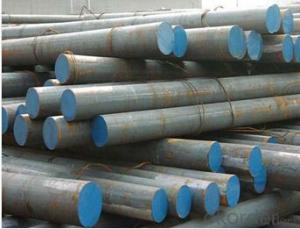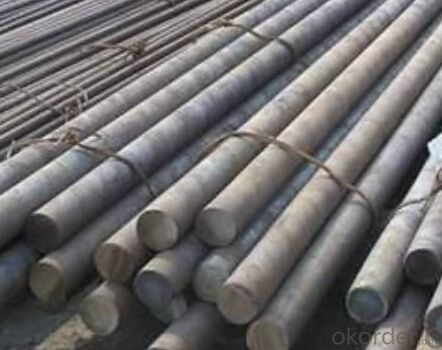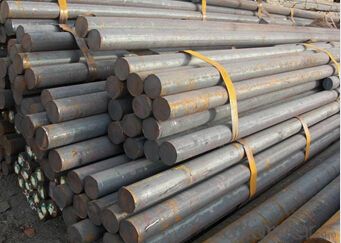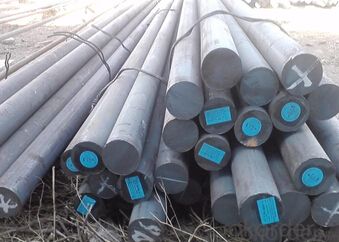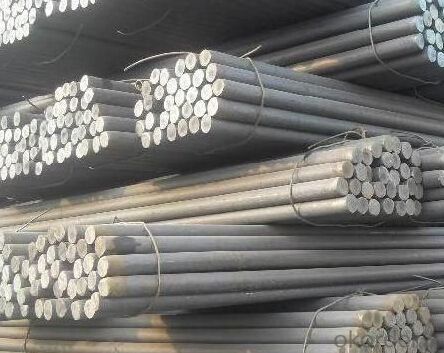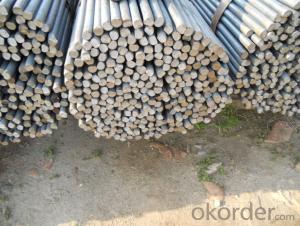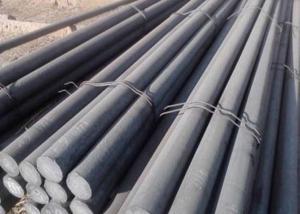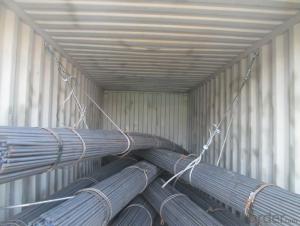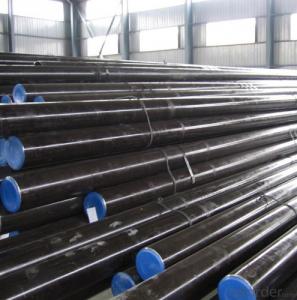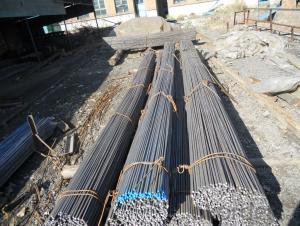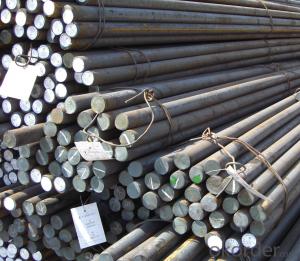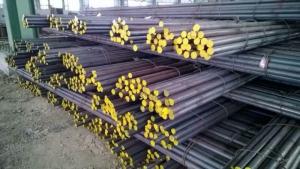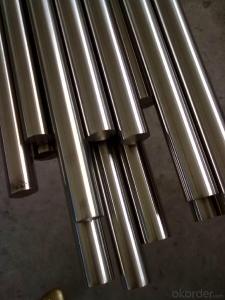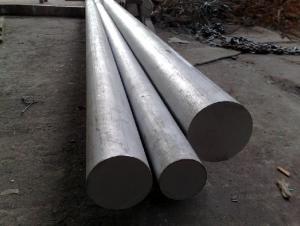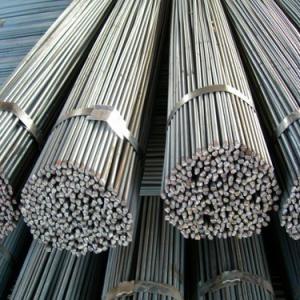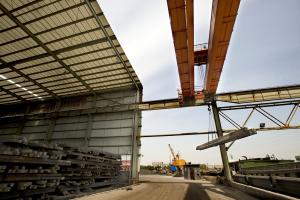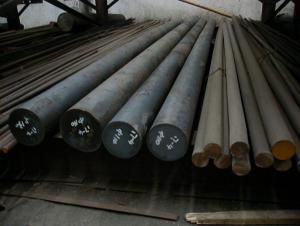Chinese Standard High Prime Round Bar Steel
- Loading Port:
- China Main Port
- Payment Terms:
- TT or LC
- Min Order Qty:
- -
- Supply Capability:
- -
OKorder Service Pledge
OKorder Financial Service
You Might Also Like
Product Description:
OKorder is offering Chinese Standard High Prime Round Bar Steel at great prices with worldwide shipping. Our supplier is a world-class manufacturer of steel, with our products utilized the world over. OKorder annually supplies products to European, North American and Asian markets. We provide quotations within 24 hours of receiving an inquiry and guarantee competitive prices.
Product Applications:
Chinese Standard High Prime Round Bar Steel are ideal for structural applications and are widely used in the construction of buildings and bridges, and the manufacturing, petrochemical, and transportation industries.
Product Advantages:
OKorder's Steel Chinese Standard High Prime Round Bar Steel are durable, strong, and resist corrosion.
Main Product Features:
· Premium quality
· Prompt delivery & seaworthy packing (30 days after receiving deposit)
· Corrosion resistance
· Can be recycled and reused
· Mill test certification
· Professional Service
· Competitive pricing
|
Specifications of Chinese Standard Round Bar
1. Grade: Q195, Q235, Q345
2. Diameter: 6mm-150mm
3. Length: 6m, 9m, 12m or as customer’s request
4. Tolerance: Within ±5% for weight; ±2mm for diameter
5. Note: The price can be better is the quantity is good
6. Chemical composition
Alloy No | Element (%) | ||||
C | Mn | S | P | Si | |
Q195 | 0.06-0.12 | 0.25 | ≤0.05 | ≤0.045 | ≤0.3 |
Q235 | 0.12—0.20 | 0.3—0.7 | ≤0.045 | ≤0.045 | ≤0.3 |
Q345 | ≤0.2 | 1.00-1.60 | ≤0.045 | ≤0.045 | ≤0.55 |
Usage and Applications of Chinese Standard Round Bar
1. Chinese standard steel bar is often used where large amounts of steel need to be formed, for example as structural steel.
2. And we can use this kind of product on the performance of the mechanical parts if the demand is not very high.
3. Steel round bar is used in construction and a large number of architectural and engineering structures.
Packaging & Delivery of Chinese Standard Round Bar
Packaging Detail: All goods are packed in bundle with steel strips and shipped by break bulk vessel or container (depend on target market and different ports)
Delivery Detail: 45 days
Trade terms: FOB, CFR, CIF
MOQ: 25 tons per specification; we can negotiate the quantity if the specification is normal or we have stock of one specification.
Weight: The price invoicing on theoretical weight basis or actual weight basis depends on customer’s request.
Shipment: The shipment of bulk break or container is depends on customer’s request and the situation of the port of destination.
Documents given: Full set of original clean on board bill of lading; Original signed commercial invoice; Original packing list; Policy of insurance; Certificate of origin and what the target market needs.
Production Flow of Chinese Standard Round Bar
1. The common processes are preheated forging quenching, dual refinement solution process, cooling quenching and isothermal quenching. We use heat treatment for dual refinement solution process.
2. Material prepare (billet) — heat up — rough rolling — precision rolling — cooling — packing — storage and transportation
Characteristics of Chinese Standard Round Bar
1. The steel in which the main interstitial alloying constituent is carbon in the range of 0.12–2.0%.
2. As the carbon percentage content rises, steel has the ability to become harder and stronger through heat treating; however it becomes less ductile.
3. Quality should be in conformity with the specification of the manufacturer. Quantity and packing conditions should be in conformity with the term in the contract.
4. Regardless of the heat treatment, higher carbon content reduces weld ability. In carbon steels, the higher carbon content lowers the melting point.
FAQ:
Q1: Why buy Materials & Equipment from OKorder.com?
A1: All products offered byOKorder.com are carefully selected from China's most reliable manufacturing enterprises. Through its ISO certifications, OKorder.com adheres to the highest standards and a commitment to supply chain safety and customer satisfaction.
Q2: How do we guarantee the quality of our products?
A2: We have established an advanced quality management system which conducts strict quality tests at every step, from raw materials to the final product. At the same time, we provide extensive follow-up service assurances as required.
Q3: How soon can we receive the product after purchase?
A3: Within three days of placing an order, we will begin production. The specific shipping date is dependent upon international and government factors, but is typically 7 to 10 workdays.
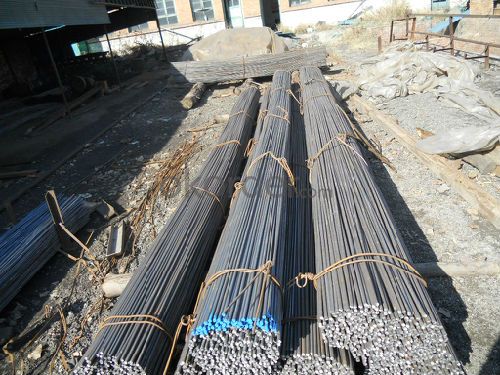
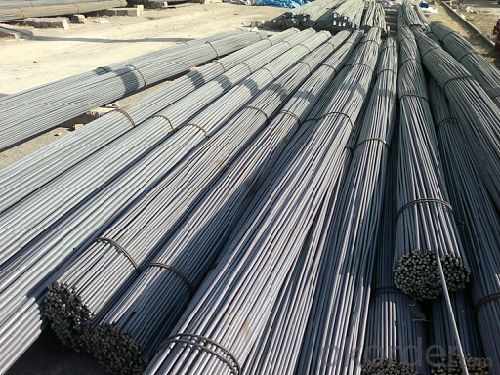
- Q: What are the corrosion resistance properties of steel round bars?
- Steel round bars have excellent corrosion resistance properties due to the presence of alloying elements such as chromium, nickel, and molybdenum. These elements form a protective oxide layer on the surface of the steel, preventing the metal from coming into contact with corrosive substances. Additionally, stainless steel round bars are highly resistant to rust and corrosion caused by exposure to moisture, chemicals, and atmospheric conditions, making them suitable for various applications in industries such as construction, marine, and manufacturing.
- Q: Can steel round bars be used in the manufacturing of springs?
- Indeed, the utilization of steel round bars in the production of springs is possible. Steel, being a prevalent material in spring manufacturing, is favored for its remarkable attributes including remarkable strength, endurance, and flexibility. By employing diverse manufacturing techniques like hot rolling, cold drawing, or machining, steel round bars can be skillfully transformed and molded into the desired spring shape. The selection of the precise type of steel round bar relies on the application and specific characteristics sought after for the spring, such as the desired level of rigidity or resilience. All in all, steel round bars are extensively employed and deemed as a dependable option for spring production.
- Q: Are steel round bars prone to deformation?
- Yes, steel round bars can be prone to deformation under certain conditions. Factors such as excessive heat, extreme pressure, or improper handling can cause steel round bars to bend, warp, or twist. However, when manufactured and used properly, steel round bars are highly durable and resistant to deformation.
- Q: What are the different types of steel round bars used in the automotive steering systems?
- In automotive steering systems, there exists a range of steel round bars with distinctive properties and advantages. 1. Carbon Steel Round Bars: These round bars are extensively utilized in automotive steering systems due to their superior strength and durability. They are suitable for various steering components like tie rods and drag links. Additionally, carbon steel round bars are cost-effective and readily accessible, making them a popular choice in the automotive industry. 2. Alloy Steel Round Bars: By incorporating alloying elements such as chromium, nickel, and molybdenum into carbon steel, alloy steel round bars enhance their strength, hardness, and wear resistance. They are particularly useful in high-stress areas of the steering system, including steering shafts and steering knuckles, where additional strength is required. 3. Stainless Steel Round Bars: Stainless steel round bars are renowned for their exceptional resistance to corrosion, making them ideal for steering components exposed to harsh environments or moisture. Steering column shafts and tie rod ends frequently incorporate stainless steel round bars. 4. Tool Steel Round Bars: Steering system components that demand high hardness, wear resistance, and toughness often utilize tool steel round bars. These bars are commonly employed in the production of steering gears and other precision steering components. 5. High-Strength Low-Alloy (HSLA) Steel Round Bars: HSLA steel round bars, a type of alloy steel, offer a favorable balance between strength, toughness, and formability. Lightweight steering system components often employ HSLA steel round bars to reduce weight while maintaining structural integrity. Ultimately, the selection of steel round bars in automotive steering systems depends on factors such as the specific application, desired strength, durability, and corrosion resistance. Manufacturers carefully choose the appropriate steel type to ensure optimal performance and safety in steering systems.
- Q: What are the advantages of using tungsten-alloy steel round bars?
- Tungsten-alloy steel round bars have become a popular choice in various industries due to their numerous advantages over other materials. Firstly, their exceptional strength and durability make them highly resistant to wear, deformation, and fatigue. By adding tungsten to the steel composition, the bars become significantly harder and tougher, enabling them to withstand heavy loads and high-pressure applications. This makes them ideal for industries such as aerospace, automotive, and construction. Another advantage of these round bars is their excellent heat resistance. Tungsten has one of the highest melting points among all elements, making it perfect for applications involving extreme temperatures. Whether it's furnace parts, cutting tools, or high-speed machinery, the heat resistance of tungsten-alloy steel round bars ensures that they maintain their structural integrity and performance in demanding environments. This reduces the risk of deformation or failure. Furthermore, these round bars possess superior corrosion resistance. The inclusion of tungsten in the steel alloy creates a protective oxide layer on the surface, acting as a barrier against corrosive elements, moisture, and chemicals. This corrosion resistance makes tungsten-alloy steel round bars highly suitable for applications in marine environments, chemical processing plants, and the oil and gas industry, where exposure to corrosive substances is common. Additionally, these round bars offer excellent machinability. Their hardness and toughness make them easy to shape, cut, and drill, allowing for precise machining and tight tolerances. This makes tungsten-alloy steel round bars suitable for manufacturing intricate components and parts that require high precision and accuracy. Lastly, the high density of tungsten-alloy steel round bars gives them unique properties, such as improved radiation shielding capabilities. This makes them invaluable in industries where radiation protection is crucial, such as nuclear power plants, medical equipment, and aerospace applications. In conclusion, the advantages of using tungsten-alloy steel round bars include exceptional strength and durability, excellent heat resistance, superior corrosion resistance, excellent machinability, and high density for radiation shielding. These advantages make tungsten-alloy steel round bars a reliable and versatile choice for various industries, ensuring optimal performance and longevity in challenging environments.
- Q: Can steel round bars be bent or formed?
- Yes, steel round bars can be bent or formed. They have the ability to be shaped into various angles or curves through the application of force, typically using tools such as a hydraulic press or bending machine.
- Q: Can steel round bars be used in the agriculture industry?
- Steel round bars find extensive use in the agriculture industry, where they serve a multitude of purposes. Commonly employed in the construction of farm equipment, fencing, and building structures, steel round bars are renowned for their robustness and longevity, rendering them ideal for demanding tasks within the agricultural sector. Moreover, these bars exhibit exceptional resistance to harsh weather conditions and corrosion, thereby ensuring their enduring reliability and durability in agricultural settings. In essence, steel round bars emerge as a versatile and pragmatic option for the agriculture industry, owing to their immense strength, durability, and ability to withstand environmental factors.
- Q: What are the typical yield strengths of different grades of steel round bars?
- The yield strength of steel round bars can vary depending on the specific grade of steel. Here are some typical yield strengths for different grades of steel round bars: - Mild steel round bars typically have a yield strength of around 250 MPa (megapascals) or 36,000 psi (pounds per square inch). - Carbon steel round bars can have a yield strength ranging from 350 to 550 MPa or 50,000 to 80,000 psi. - Alloy steel round bars, such as 4140 or 4340, generally have higher yield strengths compared to mild or carbon steel. The yield strength of these alloys can range from 550 to 850 MPa or 80,000 to 120,000 psi. - Stainless steel round bars come in various grades, and their yield strengths can vary accordingly. For example, austenitic stainless steels like 304 or 316 typically have yield strengths ranging from 200 to 300 MPa or 29,000 to 43,000 psi. On the other hand, duplex stainless steels like 2205 or 2507 can have higher yield strengths ranging from 450 to 650 MPa or 65,000 to 95,000 psi. It is important to note that these values are just typical ranges, and the actual yield strength of a specific grade of steel round bar may differ based on factors such as heat treatment, manufacturing process, and other variables. Therefore, it is always recommended to consult the manufacturer's specifications or industry standards for accurate and precise yield strength values of steel round bars.
- Q: What are the different types of steel round bar alloys for improved toughness?
- Improved toughness is a characteristic associated with various steel round bar alloys. These alloys are specifically formulated to enhance the steel's capacity to withstand impact and resist deformation. Some commonly utilized steel round bar alloys for improved toughness comprise: 1. 4140 Alloy Steel: Renowned for its exceptional toughness and high tensile strength, this alloy finds application in areas that necessitate high impact resistance, such as automotive parts, gears, and shafts. 2. 4340 Alloy Steel: Similar to 4140, 4340 alloy steel offers remarkable toughness and strength. It is frequently employed in applications requiring high fatigue resistance, such as aircraft landing gear components and crankshafts. 3. 8620 Alloy Steel: This alloy is ideal for situations that demand both toughness and good wear resistance. It is commonly employed in gears, pinions, and other high-stress components. 4. 52100 Alloy Steel: Recognized for its high toughness and excellent wear resistance, 52100 alloy steel is frequently used in bearings, valve parts, and other heavy-duty applications. 5. H13 Tool Steel: While predominantly used in hot work applications, H13 tool steel is also acknowledged for its toughness and ability to withstand high impact loads. It is often employed in die casting dies, extrusion dies, and forging dies. 6. A2 Tool Steel: A2 tool steel is another alloy celebrated for its toughness and good wear resistance. It is commonly utilized in cutting tools, punches, and dies. These examples represent merely a fraction of the numerous steel round bar alloys meticulously engineered to deliver enhanced toughness. The selection of the appropriate alloy is contingent upon the specific requirements of the application and the desired level of toughness.
- Q: What are the advantages of using precipitation-strengthened steel round bars?
- One advantage of using precipitation-strengthened steel round bars is their superior strength and hardness. The precipitation-hardening process allows for the formation of fine and evenly dispersed particles, enhancing the material's mechanical properties. This makes them suitable for applications that require high strength and durability, such as in construction, manufacturing, and automotive industries. Additionally, precipitation-strengthened steel round bars have excellent corrosion resistance, enabling them to withstand harsh environments and prolonged exposure to moisture without compromising their strength.
Send your message to us
Chinese Standard High Prime Round Bar Steel
- Loading Port:
- China Main Port
- Payment Terms:
- TT or LC
- Min Order Qty:
- -
- Supply Capability:
- -
OKorder Service Pledge
OKorder Financial Service
Similar products
Hot products
Hot Searches
Related keywords
